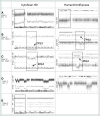Identification of prognostic relevant chromosomal abnormalities in chronic lymphocytic leukemia using microarray-based genomic profiling
- PMID: 24401281
- PMCID: PMC3905918
- DOI: 10.1186/1755-8166-7-3
Identification of prognostic relevant chromosomal abnormalities in chronic lymphocytic leukemia using microarray-based genomic profiling
Abstract
Background: Characteristic genomic abnormalities in patients with B cell chronic lymphocytic leukemia (CLL) have been shown to provide important prognostic information. Fluorescence in situ hybridization (FISH) and multiplex ligation-dependent probe amplification (MLPA), currently used in clinical diagnostics of CLL, are targeted tests aimed at specific genomic loci. Microarray-based genomic profiling is a new high-resolution tool that enables genome-wide analyses. The aim of this study was to compare two recently launched genomic microarray platforms, i.e., the CytoScan HD Array (Affymetrix) and the HumanOmniExpress Array (Illumina), with FISH and MLPA to ascertain whether these latter tests can be replaced by either one of the microarray platforms in a clinical diagnostic setting.
Result: Microarray-based genomic profiling and FISH were performed in all 28 CLL patients. For an unbiased comparison of the performance of both microarray platforms 9 patients were evaluated on both platforms, resulting in the identification of exactly identical genomic aberrations. To evaluate the detection limit of the microarray platforms we included 7 patients in which the genomic abnormalities were present in a relatively low percentage of the cells (range 5-28%) as previously determined by FISH. We found that both microarray platforms allowed the detection of copy number abnormalities present in as few as 16% of the cells. In addition, we found that microarray-based genomic profiling allowed the identification of genomic abnormalities that could not be detected by FISH and/or MLPA, including a focal TP53 loss and copy neutral losses of heterozygosity of chromosome 17p.
Conclusion: From our results we conclude that although the microarray platforms exhibit a somewhat lower limit of detection compared to FISH, they still allow the detection of copy number abnormalities present in as few as 16% of the cells. By applying similar interpretation criteria, the results obtained from both platforms were comparable. In addition, we conclude that both microarray platforms allow the identification of additional potential prognostic relevant abnormalities such as focal TP53 deletions and copy neutral losses of heterozygosity of chromosome 17p, which would have remained undetected by FISH or MLPA. The prognostic relevance of these novel genomic alterations requires further evaluation in prospective clinical trials.
Figures

Similar articles
-
Identification of chromosomal abnormalities relevant to prognosis in chronic lymphocytic leukemia using multiplex ligation-dependent probe amplification.Cancer Genet Cytogenet. 2009 Dec;195(2):97-104. doi: 10.1016/j.cancergencyto.2009.06.020. Cancer Genet Cytogenet. 2009. PMID: 19963108
-
Evaluation of MLPA as a comprehensive molecular cytogenetic tool to detect cytogenetic markers of chronic lymphocytic leukemia in Egyptian patients.J Genet Eng Biotechnol. 2021 Jun 28;19(1):98. doi: 10.1186/s43141-021-00198-z. J Genet Eng Biotechnol. 2021. PMID: 34181122 Free PMC article.
-
Genomic arrays in chronic lymphocytic leukemia routine clinical practice: are we ready to substitute conventional cytogenetics and fluorescence in situ hybridization techniques?Leuk Lymphoma. 2013 May;54(5):986-95. doi: 10.3109/10428194.2012.731598. Epub 2012 Oct 16. Leuk Lymphoma. 2013. PMID: 22994157
-
Clinical application of array-based comparative genomic hybridization for the identification of prognostically important genetic alterations in chronic lymphocytic leukemia.Mol Diagn Ther. 2008;12(5):271-80. doi: 10.1007/BF03256292. Mol Diagn Ther. 2008. PMID: 18803425 Review.
-
Genetic features of B-cell chronic lymphocytic leukemia.Rev Clin Exp Hematol. 2000 Mar;4(1):48-72. doi: 10.1046/j.1468-0734.2000.00003.x. Rev Clin Exp Hematol. 2000. PMID: 11486330 Review.
Cited by
-
affy2sv: an R package to pre-process Affymetrix CytoScan HD and 750K arrays for SNP, CNV, inversion and mosaicism calling.BMC Bioinformatics. 2015 May 20;16:167. doi: 10.1186/s12859-015-0608-y. BMC Bioinformatics. 2015. PMID: 25991004 Free PMC article.
-
Molecular basis of chronic lymphocytic leukemia diagnosis and prognosis.Cell Oncol (Dordr). 2015 Apr;38(2):93-109. doi: 10.1007/s13402-014-0215-3. Epub 2015 Jan 7. Cell Oncol (Dordr). 2015. PMID: 25563586 Review.
-
CpG Oligonucleotide and Interleukin 2 stimulation enables higher cytogenetic abnormality detection rates than 12-o-tetradecanolyphorbol-13-acetate in Asian patients with B-cell chronic lymphocytic leukemia (B-CLL).Int J Hematol. 2014 Dec;100(6):545-53. doi: 10.1007/s12185-014-1681-0. Epub 2014 Oct 10. Int J Hematol. 2014. PMID: 25301672
-
De Novo Loss-of-Function Mutations in USP9X Cause a Female-Specific Recognizable Syndrome with Developmental Delay and Congenital Malformations.Am J Hum Genet. 2016 Feb 4;98(2):373-81. doi: 10.1016/j.ajhg.2015.12.015. Epub 2016 Jan 28. Am J Hum Genet. 2016. PMID: 26833328 Free PMC article.
-
Genomic arrays identify high-risk chronic lymphocytic leukemia with genomic complexity: a multi-center study.Haematologica. 2021 Jan 1;106(1):87-97. doi: 10.3324/haematol.2019.239947. Haematologica. 2021. PMID: 31974198 Free PMC article.
References
-
- Dicker F, Schnittger S, Haferlach T, Kern W, Schoch C. Immunostimulatory oligonucleotide-induced metaphase cytogenetics detect chromosomal aberrations in 80% of CLL patients: a study of 132 CLL cases with correlation to FISH, IgVH status, and CD38 expression. Blood. 2006;108:3152–3160. doi: 10.1182/blood-2006-02-005322. - DOI - PubMed
-
- Stevens-Kroef M, Simons A, Gorissen H, Feuth T, Olde Weghuis D, Buijs A, Raymakers R, Geurts van Kessel A. Identification of chromosomal abnormalities relevant to prognosis in chronic lymphocytic leukemia using multiplex ligation-dependent probe amplification. Cancer Genet Cytogenet. 2009;95:97–104. - PubMed
-
- Edelmann J, Holzmann K, Miller F, Winkler D, Buhler A, Zenz T, Bullinger L, Kuhn MW, Gerhardinger A, Bloehdorn J, Radtke I, Su X, Ma J, Pounds S, Hallek M, Lichter P, Korbel J, Busch R, Mertens D, Downing JR, Stilgenbauer S, Dohner H. High-resolution genomic profiling of chronic lymphocytic leukemia reveals new recurrent genomic alterations. Blood. 2012;120:4783–4794. doi: 10.1182/blood-2012-04-423517. - DOI - PubMed
LinkOut - more resources
Full Text Sources
Other Literature Sources
Research Materials
Miscellaneous

